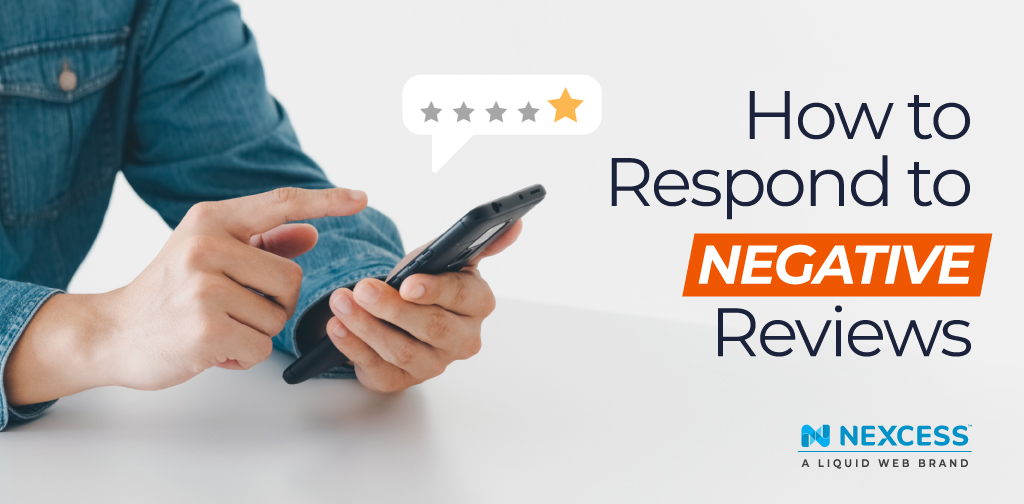Positive reviews are great for showing potential customers that they can trust your business. But what happens when reviews pop up that aren’t so positive? Learning how to respond to negative reviews the right way can prevent any damage they might cause and show your customers that you’re dedicated to serving their needs.
Why Reviews Matter
Before someone makes a purchase, they want to know they aren’t wasting their money. Reviews can put customers’ minds at ease, but reviews are essential for other reasons.
Improve Search Rankings
Reviews play a critical role in how Google places your business’s website in search rankings. The more reviews your business has, the more likely your business is to appear in searches. But that’s not the only way reviews help customers find your business. Your reviews also appear alongside your Google Business Profile information. Local customers can see your star rating before looking up anything else about your company.
Lead to Higher Conversion Rates
If you want to learn how to improve ecommerce conversion rates, consider adding reviews to your site. Reviews can be the difference between a customer on the fence and a customer who is ready to click the buy button. People are more likely to purchase if other people agree that it’s a good choice. Online reviews are a significant source of social proof and make customers feel more confident in their purchases.
Make You Look Trustworthy
Reviews are a key ingredient of your brand’s online identity. Customers tend not to trust businesses that have ratings below four stars. Having higher star ratings can build trust with customers and make your business more reliable in their eyes. So, even though the distance between a four-star and five-star review may seem small, companies with higher ratings are more likely to make sales because customers feel they can trust them more.
Essential for Decision Making
The majority of shoppers think online reviews are crucial to their purchase decisions. They consult sites like Google and Yelp to help them make these decisions. And they’re more likely to look at those sources than they are to ask friends and family. Having customers talk about your brand and their experience with it is a great form of advertising. And encouraging customer reviews can lead to more customers in the future.

Open Line to Customers
Online reviews aren’t just a way for your customers to share their experiences. They’re also how customers share their experiences with you. Reviews act as a way for customers to be honest about their purchases and experience. These reviews allow you to thank your customers or offer them future promotions. But most importantly, these reviews allow you to act fast and fix any issues a customer has to show that you care about them and value them as customers.
How to Respond to Negative Reviews
Reviews can do a lot to entice new customers and build your company’s reputation. But negative reviews can stick out and prevent new customers from trusting your brand. That’s why it’s crucial to learn how to respond to negative reviews quickly and efficiently. The following steps can help you prevent any harmful effects negative reviews may have.
Respond Quickly
Any time you spot a bad review, take time to read it and make a plan for addressing it. Responding within 24-48 hours is ideal. You don’t want a bad review to be left unanswered. If a customer was so unhappy with your company that they decided to leave a review, it should be your top priority.
Be Professional
A negative review can feel like being called out, but it’s no time to start a fight. Respond calmly and clearly, and state what you will do to fix the customer’s negative experience. Even though some reviewers may use inflammatory language or seem childish, remaining professional is essential. Even if one customer uses a review to insult your brand, other customers watch how you respond.
It’s also a good idea to have a process for addressing negative reviews. Creating a reference for employees to follow can be a great way to educate team members about how you’d like to handle these situations. Plus, it creates a cohesive approach should you need to delegate the task of responding to someone else.
Acknowledge the Complaint
If a reviewer had a bad experience or received a faulty product, acknowledge it. Showing empathy can go a long way, and customers will appreciate that you took the initiative to fix any issues.
Acknowledging complaints can also be an excellent way to prevent any compounding effects of harmful product reviews. Responding to a negative review with something as simple as “we’re sorry you had a bad experience” can make the customer feel seen and prevent the bad review from further damage.
Apologize and Take Responsibility
Apologizing to a customer, rather than arguing with them, is an integral part of customer service. Showing the customer that you hear their complaint, are sorry it happened, and will do better next time can show future customers that you hold your business to a high standard and they shouldn’t expect to have the same experience as the bad review.
Provide an Explanation, If Needed
Not all negative reviews require an explanation, but they might depending on what’s in the review. Businesses err and products occasionally fall short. Explaining poor material quality, miscommunications, technical issues, slow delivery times, or product backorders can help customers understand what happened and be more ready to forgive your business for their bad experience.
When explaining, make sure you aren’t justifying a lousy experience. You don’t want to sound like you’re making excuses. Make it clear that you are sorry when you explain. Let the reviewer know what you can offer to make up for their experience.
Take the Discussion Offline
All reviews are public, and just as the good reviews can build customer trust, the bad ones can break that trust. The more visible your response, the more people will see it. Suggest in your response to the negative review that you’d like to move the discussion to a private place, like email or a phone call, so not all customers can see the entirety of this conversation.
Make It Right
Even if a customer’s bad experience wasn’t directly the fault of your business, take responsibility and reinforce your business’s high standards. Make it clear that you are equally disappointed that they had a bad experience. Consider offering a refund or a free service or product to make things right.
Making it right might also encourage the reviewer to remove the negative review. But, at no point should you ask them to remove it. Your customers want to feel like you hear their complaints, and asking for a review to be removed can ignite further controversy.
Examples of Responses
Responding to a negative review doesn’t have to be complicated. Here are some examples of how you can respond next time you get one:
- Thank you for your review. We’re sorry you had a bad experience. We promise to do better in the future.
- Thank you for bringing this to our attention. We’re sorry your experience didn’t match your expectations or ours. We’re looking into the issue and hope to resolve it quickly.
- Thank you for letting us know. We set high standards for our company, and we’re sorry we didn’t meet them. We would like the opportunity to chat directly with you to make this right.
Building a Better Customer Experience
Learning to deal with negative reviews is just one step in managing your brand’s online reputation. Having the proper tools to serve your customers can mean the difference between satisfaction and disappointment. When creating a seamless and intuitive customer experience, Nexcess has your back. Power your online store with fully managed WooCommerce hosting and radically improve load times to serve your customers better.
Check out our fully managed WooCommerce plans to get started today.

